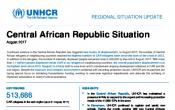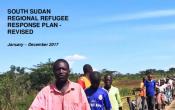Central African Republic
Operation: Central African Republic
Location
{"longitude":20,"latitude":7,"zoom_level":0}
Latest update of camps and office locations 21 Nov 2016. By clicking on the icons on the map, additional information is displayed.
Key Figures
| 2018 planning figures | |
| 53,000 | households will receive core relief items |
| 42,900 | internally displaced households will receive long-term shelter |
| 32,000 | tool kits and materials will be provided for shelter maintenance |
| 10,100 | targeted refugee households will receive transitional shelter |
| 3,500 | people of concern with specific needs will receive support |
| 900 | registered refugee and asylum-seeker children targeted to be enrolled in primary education, with a focus on scholarships for asylum-seeker girls |
| 6 | community-based committees/groups working on SGBV prevention and response |
| 2016 end-year results | |
| 100% | of refugees have access to primary health care |
| 235,200 | IDPs supported with return packages (core relief item kit or cash) |
| 6,900 | newly internally displaced households were assisted with core-relief items |
| 1,300 | reported SGBV incidents for which survivors received psychosocial counseling |
Latest Updates and Related Links
People of Concern
9%
Decrease in
2016
2016
| 2016 | 458,607 |
| 2015 | 503,964 |
| 2014 | 1,057,544 |

[["Refugees",12115],["Asylum-seekers",304],["IDPs",411785],["Returned refugees",34403]]
Loading ...
Central African Republic
< Back
2016
{"categories":[2013,2014,2015,2016,2017,2018],"budget":[26.61966467,72.99517142,51.41588869,57.558703669,53.08443808,41.269420503],"expenditure":[11.6062205,30.83826436,28.05206276,27.75001507,null,null]}
{"categories":[2013,2014,2015,2016,2017,2018],"p1":[9.90859819,22.2141765,11.20435682,13.828749925,24.29164077,9.355281568],"p2":[5.51967978,null,null,null,null,null],"p3":[5.07016298,null,null,18.01743734,14.76256501,20.659162443],"p4":[6.12122372,50.78099492,40.21153187,25.712516404,14.0302323,11.254976492]}
{"categories":[2013,2014,2015,2016,2017,2018],"p1":[6.64581075,10.9546183,9.49333057,10.97116821,null,null],"p2":[0.0895701,null,null,null,null,null],"p3":[null,null,null,7.6601341,null,null],"p4":[4.87083965,19.88364606,18.55873219,9.11871276,null,null]}
Loading ...
CHOOSE A YEAR
- 2014
- 2015
- 2016
- 2017
- 2018
Year-end Overview
Plan Overview
Working environment
In 2018, the Central African Republic (CAR) is expected to face continued instability that will drive ongoing mass displacement, with numbers climbing higher than those of 2017. UNHCR will need to remain flexible to respond to crises in new areas of the country. It will look to strengthen the existing coordination mechanisms to deliver wider and to ensure that any gaps in the response are addressed.
The fragility of the situations in Democratic Republic of the Congo (DRC) and South Sudan, and continued instability in the southern border regions of Chad, will see an estimate afflux of 18,500 new refugee arrivals during the course of the year.
The political landscape will continue to improve. The next presidential elections are scheduled for 2021, and the State will slowly extend its reach throughout 2018. This will offer an increasing scope for UNHCR to work in partnership with civil authorities in supporting return and reintegration activities, and in assisting in the re-establishment of essential services in the areas less affected by violence. These areas may also see a shift away from humanitarian towards transitional and developmental activities. Once ‘go-and-see’ visits have been carried out, UNHCR is expecting to see a reduction in the number of Central African refugees repatriating, though it is anticipated that some 25,000 people will return in 2018.
The government will continue to offer the refugee populations asylum in alignment with its open-border policy, and access to essential services, such as health and education.
The MINUSCA mandate and presence will remain broadly unchanged from 2017, and will continue ensuring security in the capital Bangui, and other major towns of strategic importance, such as Bambari.
The activities of armed groups will mean a continued operational focus on protection monitoring and site management.
Key priorities
In 2018, UNHCR will focus on:
- Increasing the distribution of non-food items and emergency shelter assistance to the growing numbers of IDPs;
- Strengthening coordination to better manage and deliver assistance for returning refugees and IDPs. UNHCR will deepen its partnership with the main government agency dealing with reintegration, the Projet d'Appui au Retour et à la Réintégration en République Centrafricaine (PARET);
- Improving refugees’ access to basic social services, with a particular emphasis on primary and secondary education. UNHCR will achieve this through increased support to existing government infrastructure;
- Joint projects with UN agencies, as co-financed projects play a larger role in financing the operation.






